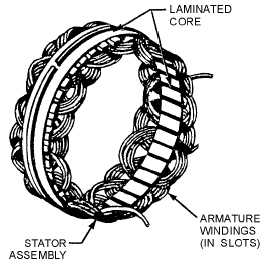3-4
The stators of all rotating-field alternators are about the same. The stator consists of a laminated iron
core with the armature windings embedded in this core as shown in figure 3-2. The core is secured to the
stator frame.
Figure 3-2.—Stationary armature windings.
Q2. What is the part of an alternator in which the output voltage is generated?
Q3. What are the two basic types of alternators?
Q4. What is the main advantage of the rotating field alternator?
PRACTICAL ALTERNATORS
The alternators described so far in this chapter are ELEMENTARY in nature; they are seldom used
except as examples to aid in understanding practical alternators.
The remainder of this chapter will relate the principles of the elementary alternator to the alternators
actually in use in the civilian community, as well as aboard Navy ships and aircraft. The following
paragraphs in this chapter will introduce such concepts as prime movers, field excitation, armature
characteristics and limitations, single-phase and polyphase alternators, controls, regulation, and parallel
operation.
FUNCTIONS OF ALTERNATOR COMPONENTS
A typical rotating-field ac generator consists of an alternator and a smaller dc generator built into a
single unit. The output of the alternator section supplies alternating voltage to the load. The only purpose
for the dc exciter generator is to supply the direct current required to maintain the alternator field. This dc
generator is referred to as the exciter. A typical alternator is shown in figure 3-3, view A; figure 3-3, view
B, is a simplified schematic of the generator.


